>> Back to The HooK front page
COVER- Speed queens: Local women go the distance
Published September 2, 2004 in issue 0335 of the Hook

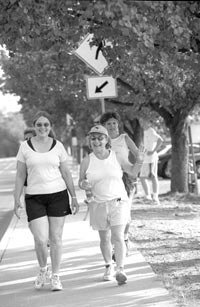
BY SUSAN TYLER HITCHCOCK
Notice all the women running around in Charlottesville? Early morning, lunch breaks, after work, evening hours? Young and old, fat and fit, they're putting on their tank tops, shorts, and shoes and taking to the paths and pavement. Chalk it up to the summer's preeminent athletic event, the Labor Day weekend Women's Four-Miler. This Saturday, 1,850 women will run the four-mile course on Garth Road, starting and ending at Foxfield, beginning at 8am.
"This is the largest all-woman race in Virginia," says Cynthia Lorenzoni, volunteer director of the Four-Miler and owner, with her husband, Mark, of Ragged Mountain Running Shop.
"Mark and I started this race 22 years ago," Lorenzoni says. At that time, she was running races like the New York and Boston marathons-- urban road races with closed streets and big media coverage. But she was also involved in smaller running events for women. The two activities coalesced as the Lorenzonis got to know Charlottesville, and soon, in association with the Charlottesville Track Club, they organized the Women's Four-Miler.
"That first year, we had 350 runners," says Mark Lorenzoni, volunteer race director from its 1983 founding to 1989. "I thought, 'This is amazing. It can't possibly get any bigger.' " Last year, 1,600 women ran; this year, registration closed in early July at 1,850.
All Four-Miler proceeds go to the breast cancer division of UVA's Cancer Clinic. Looking back, Cynthia Lorenzoni thanks Connie Friend, the first director of the training program, for making the connection.
"It just kind of makes sense," says Lorenzoni. "It's a woman's cause. Women feel passionate about it." She herself feels that passion. She and her two sisters, having helped their own mother through her successful battle with breast cancer, recognize that they are at high risk for the disease.
All proceeds from the Four-Miler-- entrance fees plus special donations in memory of breast cancer victims and survivors-- now support extensive post-operative health education offered by UVA's Breast Care program. Last year, the race donated $35,000. This year, the total may reach $40,000.
That money, says Diane Cole, Cancer Center Education Coordinator, provides breast cancer patients with a 10-week exercise and nutrition program taught by Medfit Wellness.
"We find that it makes a significant difference," says Cole. "Patients move from fatigue-- a different kind of fatigue, where a nap doesn't really make you feel better-- to being fairly mobile and getting back to a normal life routine."
A self-help book for breast cancer patients-- published in paper and available at healthsystem.virginia.edu/internet/cancer/selfhelp.cfm-- as well as a videotape, "Getting Stronger," were also produced with Four-Miler funding.
So that the benefits of running reach all levels, in 1983 Mark Lorenzoni developed a summer-long training schedule for beginning runners. It has evolved into an organized training program that this year attracted nearly a thousand women.
Runners in the training program receive a fat notebook with clippings, handouts, coupons, and a training schedule that starts with a half-mile walk/run in mid-June and builds to four miles by mid-August. Volunteer coaches called "pink ladies" lead four "rookie runs" a week, on Tuesday and Thursdays at 6:30am and Monday and Wednesdays at 6pm. All summer, women runners in training meet at the UVA track at 7:45am on Saturday, hearing speakers on topics that range from foot biomechanics to running safety to fitting exercise into a busy schedule.
"The hormones are so strong there," says Joan Esposito, volunteer director of the training program. Everyone strives for a win, but with all that womanly compassion, any win spills over to be shared by all. Runners call out, "Good job!" and "Way to go!" no matter if the runner is fast or slow.
"The applause is the loudest for those at the back of the race," says Esposito. To them, she calls out, "You win! You were out there the longest!"
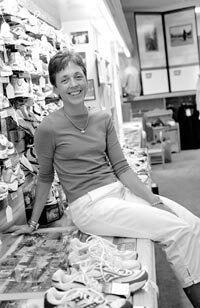 Cynthia Lorenzoni Cynthia Lorenzoni
Eyes on others: UVA chaplain guards the 'trekkers'
Mildred Best remembers when her skills as a runner and her skills as a chaplain at UVA Hospital intersected.
"I was working with a gentleman who was very anxious about his loved one-- unusually anxious," says Best. "I said to him, 'What do you do to keep yourself calm?' and he told me, 'Sometimes it helps me to run.' "
Best happened to be wearing her pedometer. She pulled it out and suggested they take a brisk walk through the hospital hallways. "We walked together, and he shared his concerns, and he did work off some energy and anxiety," she remembers.
Most of the time, though, running and walking represent a better lifestyle for Best. The 50-year-old mother of an 11-year-old girl is UVA's associate director of chaplaincy and pastoral education. She had done some aerobics and walked for exercise, and in 2001 she heard about the Four-Miler training.
Now, she's a "pink lady"-- a volunteer coach -- and concentrates, true to her character, on the participants who need help the most: the younger runners, called "Crazy Legs," and the walkers, called "Trekkers."
A constant theme throughout the training program is that walking four miles, or combining walking with running, is perfectly acceptable.
During the race itself, Best moves along through the walkers and slower runners. Last year, for example, she spotted a young woman who was near fainting. She later learned that the entrant had not been training-- a problem even for those who walk.
"For some of them, this is their first time to be part of a consistent training program and race," says Best. "Even for those who choose to walk, not run, their lives are changed."
For one woman after another, Best points out, the summer of training may be a rare opportunity to dedicate time toward the most neglected person in her life: herself. "With a lot of women," Best explains, "we take care of everybody else first."
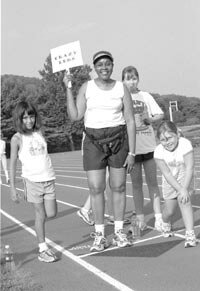
Mildred Best with three "crazy legs," young runners in training
Reality check: Four miles is short-- until you run it
"It's tough," says Tarti Djakaria, as she finishes running her three miles during the final Saturday training session. She recalls how in high school in her homeland of Indonesia she had trouble finishing even a one-kilometer run. But here she is, running three miles-- and, once so far, four-- in training to run for the full four miles on race day.
"It hurts for a while," she says, "but this program makes it easier. We start slow and gradually increase the mileage. Often I walk and run.
"When I first heard about the race, I thought, 'Four miles? That doesn't sound so bad,' " she says. Soon she faced the reality. "It turns out to be much harder than I thought."
In fact, for the first three or four weeks of training, Djakaria didn't feel much effect from the exercise, since the distances are so slight. But by the sixth week, when training runners have worked up to two and a half miles, she could tell the difference. And the rewards are starting to show.
A month ago her doctor asked her if she was an athlete. Djakaria answered no, but wondered why the question even came up. "You have a very slow resting pulse rate," the doctor told her. Djakaria wasn't sure what that meant. "That's good," the doctor told her.
At home, 37-year-old Djakaria also feels the benefits. "I'm a part-time worker and a full-time mother," she says. "I have an overactive five-year-old. It used to be hard to keep up with her before. Now I feel more energized."
In Indonesia, Djakaria says, individuals often confine their running to early mornings-- say, 5am-- before the sun comes up. Even in Missouri and Texas, where she attended universities, she never encountered such an organized training program.
"This is the first," she says. "Charlottesville is as a town more vibrant."
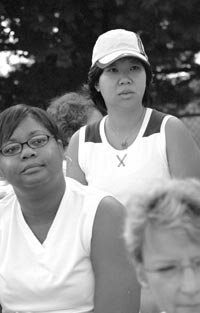
Tarti Djakaria
Mother-daughter: Dedicated to the friend they love
Mother and daughter Gay Carver and Cara Carver had planned on training and running the race with Gay's friend and coworker Beverly Taylor. After undergoing surgery and treatment for ovarian cancer, Taylor battled back to complete last year's training and successfully run the four-mile race. She had so much fun, she got Gay and Cara interested. Then the cancer came back.
Because of her treatments, she will not be running along Garth Road next Saturday, but she will be there in spirit.
"We're running in her honor," says Gay Carver, 55, a real estate assessment supervisor for Albemarle County. She is also a mother of three and grandmother of five, who has been running on her own for years and competed in the Women's Four-Miler in 1996.
Back then, though, she says, she knew nothing about the training, so this is her first year attending the 12-week program. "I really enjoyed it," she says. "It's definitely beneficial, not only to beginners but also to people who are good runners already."
Her daughter, 24-year-old Cara Carver, ran competitively in high school but had not put on running shoes since. "I feel a lot healthier now," she says. She's less concerned about winning the race, more dedicated simply to completing it. "If I finish, I'll be happy-- but I'm not nervous about it," she says.
Her mother agrees. "As Beverly says, as long as you finish, you're doing great. We're doing it for her."
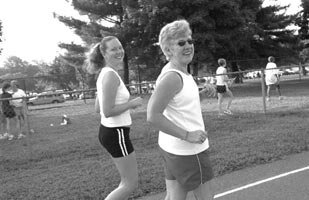
Cara and Gay Carver
Rebirth: Girl power + exercise = recovery
During the Four-Miler, runners race past banners declaring the names of women who had fought breast cancer. It's called the "Motivation Mile." In 2003, one of those names was Michele Durham.
"At that time, a year ago, I was in a real weak place in time," says Durham. "I had just finished chemotherapy. I was in the middle of moving. My body was not mine at the time." She still has the banner with her name. In fact, she'll be waving it in high spirits this year as she steps up to the starting line, ready to run four miles.
Durham had always been athletic, playing lacrosse and swimming in high school and taking ballet and tap dance for 14 years. Even after giving birth to her daughter, now 15, she worked hard to get back into shape with high-impact aerobics.
Then came the news, right around Christmas 2002, that she had breast cancer. In January 2003 she underwent a lumpectomy and axillary dissection, which removed 16 lymph nodes. She looks back now with passionate gratitude to the doctors and nurses who treated her at the UVA Breast Cancer Clinic. "They made me feel like I was the only patient in the whole world," she says.
Still, recovery was difficult. She tried to keep working in her job as a massage therapist and OR scrub nurse in labor and delivery at UVA. "I just rode the wave with it and tried not to show it," says Durham. Many days, her energy level plummeted.
"My daughter would want to go to the mall, and I would say, 'Honey, I'm so tired, I just have to lie down.' " Her daughter would get furious. "She would yell at me, things like 'It's not my fault that you have cancer.' I think it scared her to death," Durham says.
For Durham, who had never run before in her life, the summer-long training has been a journey. "It's like a rebirth of the old Michele," she says. "Do I attribute this to girl power, being around all these women who understand what you're talking about? Or is it physical-- the value of all this exercise? I think it's some of both."
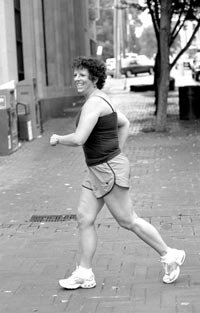
Michele Durham
The coach: Laughing all the way... to the finish line
On Saturday, June 19, Joan Esposito played the fool for her favorite cause. She greeted the 900-plus women who came to the UVA track at 7:45am and gave them tips on how to progress from zero to four miles in 12 weeks.
"Take care of your skin and eyes. That summer sun is a killer," she said, donning goofy foot-wide sunglasses.
"Those breast ligaments are precious, so wear a good sports bra." She strapped a 52EEE over her tank top.
"And some of us of a certain age might experience a little bladder control problem," she continued. "Don't worry," she says while pulling a giant-sized Depends up over her running shorts. "You're not alone."
It has been like that all summer.
As volunteer director of the Women's Four-Miler training program, Esposito is the life of the party. A Charlottesville resident for more than three decades, she works as a realtor for Roy Wheeler and has taught aerobics for the county's Parks and Recreation Department and at Farmington and the Boar's Head. She has run-- and won-- her share of races, starting with a 5K in 1980.
Now, she admits, she runs a 13-minute mile, but that pace makes her an all the more authentic inspiration for many of the Four-Miler participants. "The average age of runners in our training program is 43," Esposito proudly states. Her own age? "Sixty-- plus or minus."
"Our target population is not the elite athlete," says Esposito, who has helped the training program more than triple in attendance, from 300 in 2001 to 1,000 this year. "We're here for women who want to get in shape for the first time ever, for women who just had babies, for women who can't afford to join fancy gyms."
It wasn't an easy summer for Esposito. After the last training session at the track, Esposito moved her daughter-- her youngest of three children-- into a first-year dorm at UVA. Earlier in August, her ailing mother, 92, died.
"She is amazing," says Deborah Johnson, a first-time runner last year and a coach this year. "She is our fearless leader and head cheerleader, and we all admire her so much."
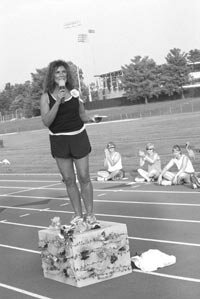
Joan Esposito
Ratcheting up: From easy jogger to runner to coach
"My husband and I did a little bit of jogging back when we were married, in '77," says Debby Johnson, thinking of how far she has run since then. "We're talking easy jogging, just to get your heart rate up, just a mile or a mile and a half. So four miles seemed really daunting."
But once she heard about the Women's Four-Miler and the associated training program, Johnson started talking it up. She told fellow members of the Charlottesville-Albemarle Legal Staff Association-- Johnson is a real estate paralegal-- and she told fellow members of the singing group Spirit Bound.
A 52-year-old mother of three grown children, Johnson joined the 2003 training, buoyed by a group of friends who would run and carpool with her.
She had her own reason to start running-- one shared by many of the middle-aged Four-Miler runners : "I had gained so much weight and was not able to lose it." In 15 months of running, she has lost 30 pounds.
She had another, deeper reason. "My partner, mentor, and soul mate, Bob Gottschalk, founder and owner of C-Digital, died of leukemia in June 2002," says Johnson. "The fight against cancer is near and dear to me."
Running last summer felt so good that Johnson continued all winter. During the summer she had attended the program's early-morning "rookie runs"-- 6:30 warm-ups, runs, and cool-downs, led by experienced runners, which start and end at the UVA track. That practice continues informally throughout the winter, and Johnson was there, rain, sleet, or snow, to get in her morning run with the fellow runners who had become her friends.
"All winter long, I was there, Tuesday and Thursday at 6:30 at the track, even on days when it was not very good footing. We would just sidestep the ice patches," she remembers.
This year, Johnson volunteered as a "pink lady"-- a Four-Miler coach. It has added another level of meaning to the race. "You see people out there who haven't been active for 30 or 40 years," she says. "People out there making a change in their lives."
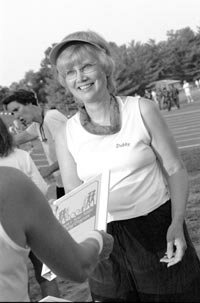
Debby Johnson
Grandma's rebound: Just a year after cancer surgery
"I had a suspicious mammogram, so they had me come back for another," remembers Karen Morris. She was 66 years old and had always done floor exercises for her bad back, took her dogs out for daily walks, and had recently discovered yoga.
"So I had another mammogram, then a sonogram, then a biopsy," she says. "Sure enough, it was cancer. You never expect to hear that."
She had surgery last year, not once but three times before doctors declared it a success and began chemotherapy last summer. She had a little break in treatment over the holidays, then started radiation, which lasted until March.
"I always felt relatively well," says Morris. At the end of radiation, "I was pretty tired, but also so excited to be free of treatment."
Throughout, she continued to attend yoga classes at Blue Ridge Yoga. "I really never stopped," says Morris. "It made a huge difference."
The mother of four and grandmother of ten also kept working. For years the head reference librarian at Gordon Avenue Library, Morris substituted as a librarian throughout the Jefferson-Madison Regional Library system.
Hers was a hormone-receptive cancer, which meant that estrogen levels in her own body might encourage a recurrence. For that, doctors prescribed tamoxifen, a non-steroidal anti-estrogen commonly used against breast cancer.
"But everybody on tamoxifen has a weight problem," says Morris. "When a friend told me she was going to do the Four-Miler, I thought that maybe running would counteract that." No such luck. But at least she hasn't gained any weight over this summer. Who knows what the scales would show if she had not been running?
Morris has been a part of the Women's Four-Miler training program all summer. "Most of all it really is a lot of fun," she says. She has found fellow runners in her neighborhood, all younger than she is, but that doesn't matter. Thanks to their shared passion for running, "We have cemented friendships."
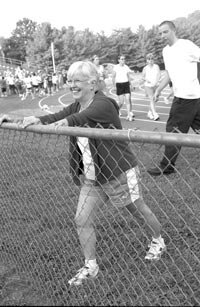
Karen Morris
Family footwork: Why's a mom running with her girls?
All summer long, Karen Roland and her three daughters have been hitting the track together. Many a Saturday at the UVA track, and then most Monday and Wednesday evenings in their own neighborhood, Candice (12), Charlotte (10), and Haley (9) suit up and take off with mom.
The idea started with Karen, who knew one of the women volunteering to be a "pink lady" coach. "Training to do the Women's Four-Miler sounded fun for a mother-daughter adventure," she says.
Of the three girls, only Charlotte was already involved in athletics. She plays soccer, so she's happy to bump up her running skills. Last Saturday, as her mother and two sisters attended the final training session before the big race, Charlotte didn't make it. Her evening soccer game the night before had worn her out, but she promised she would be a part of the family team on race day.
Her older sister, Candice, remembers how hard it was to finish a run in school PE class. "We only would run up to a mile, sometimes shorter-- and now I run four miles. I'm one of the best runners at school, and I used to be one of the worst."
Haley, at nine, already appreciates the good effects running has on her physique. "You fit into more clothes better," she has noticed. She also just likes the sensation of running. "When there's a breeze," she says, "it feels so nice to run."
Karen, a 39-year-old physical therapist, has always exercised, but until this summer it was lifting weights, swimming, biking, and walking. "I walked because I didn't think I could be a runner," she says. "Now I'm about to reach four miles. I feel stronger."
Karen Roland has another personal motivation for achieving the Women's Four-Miler. As a physical therapist, she has two patients currently who are battling cancer. "I thought I would do this for them," she says. "It has boosted them. "
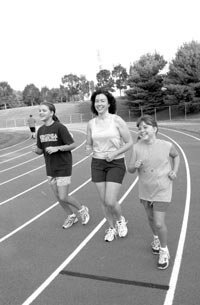
Candice, Karen, and Haley Roland
Goodbye, couch: Toddler's mom takes off
"I'm not the kind of person who goes to the gym on a regular basis," says Allison Teweles. "Of all the things I would do to exercise, running would be the last." And yet the social aspect of the Women's Four-Miler training-- the training sessions every Saturday morning at 8am and the "rookie runs" along the Greenbelt-- drew her into the training, the race, and a newfound love of running. She hasn't missed a single session.
"I was a 31-year-old couch potato whose only exercise was running after my 18-month-old son and the occasional 'bust-a-move' when a really good song comes on the car radio," says Teweles, a development officer for UVA's McIntire School of Commerce. "I'm sitting there. Nodding my head to the beat. Wow-- work those neck muscles, right?"
And now she can run four miles. She has already run that far during the training, and she will do it again on race day. "I feel awesome," she says. "It's something I can brag about."
Teweles thanks her husband for being willing to deviate from their normal weekend routine. "We used to trade off weekends," she says-- one parent slept in while the other woke early for childcare duty. For the past 12 weeks, though, both parents have risen early, but Allison has headed for the UVA track and the training program while her husband has stayed with their son, Brian. "They'll be at the finish line, cheering for me next Saturday," she says.
Although Teweles downplays the physical gains she has made from running, she knows it is preparing her for a healthier future.
"I met a woman the other day who's part of the training," she says. "She has a son about Brian's age and a little girl about seven months old. She's still nursing-- and she can make it work, training and running the race. That's inspirational.
"We're thinking about having another child. You know how the second time around, you're a little softer," she says ruefully, "so it makes me feel better, going into it, knowing I can keep running."
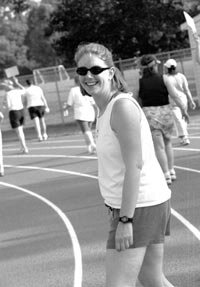
Allison Teweles #
>> Back to The HooK front page
|